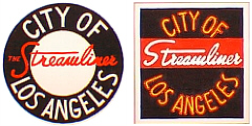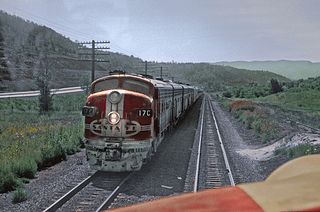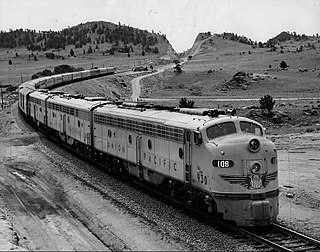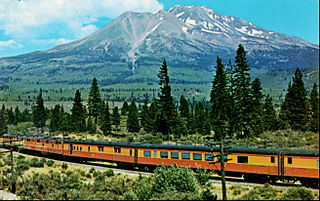
The Broadway Limited was a passenger train operated by the Pennsylvania Railroad (PRR) between New York City and Chicago. It operated from 1912 to 1995. It was the Pennsylvania's premier train, competing directly with the New York Central Railroad's 20th Century Limited. The Broadway Limited continued operating after the formation of Penn Central (PC) in February 1968, one of the few long-distance trains to do so. PC conveyed the train to Amtrak in 1971, who operated it until 1995. The train's name referred not to Broadway in Manhattan, but rather to the "broad way" of PRR's four-track right-of-way along the majority of its route.

The Super Chief was one of the named passenger trains and the flagship of the Atchison, Topeka and Santa Fe Railway. The then-modern streamliner was touted in its heyday as "The Train of the Stars" because it often carried celebrities between Chicago, Illinois, and Los Angeles, California.

The City of Denver was a streamlined passenger train operated by the Union Pacific Railroad between Chicago, Illinois, and Denver, Colorado. It operated between 1936 and 1971. From 1936–1955 the Chicago and North Western Railway handled the train east of Omaha, Nebraska; the Chicago, Milwaukee, St. Paul and Pacific Railroad handled it thereafter. The train was the fastest long-distance train in the United States when it debuted in 1936, covering 1,048 miles (1,687 km) in 16 hours. For almost its entire career its principal competitor was the Chicago, Burlington and Quincy Railroad's Denver Zephyr. When Amtrak assumed operation of most intercity trains in the United States in 1971, it discontinued the City of Denver, preferring to use the Burlington's route between Chicago and Denver.

The City of Los Angeles was a streamlined passenger train between Chicago, Illinois, and Los Angeles, California via Omaha, Nebraska, and Ogden, Utah. Between Omaha and Los Angeles it ran on the Union Pacific Railroad; east of Omaha it ran on the Chicago and North Western Railway until October 1955 and on the Milwaukee Road thereafter. The train had number 103 westbound and number 104 eastbound.

The Union Pacific Railroad's M-10001 was a diesel-electric streamlined train built in 1934 by Pullman-Standard with a power system developed by General Motors Electro-Motive Corporation using a Winton 201A Diesel engine and General Electric generator, control equipment and traction motors. It was the UP's second streamliner after the M-10000, their first equipped with a diesel engine and was a longer train than its three-car predecessor. All cars were articulated—trucks were shared between each car. It was delivered on October 2, 1934, and was used for display, test and record-setting runs for the next two months before being returned to Pullman-Standard for an increase in power and capacity, following which it was placed into service as the City of Portland train. It has been nicknamed "The Banana".

The Union Pacific Railroad's M-10002 was a diesel-electric streamliner train built in 1936 by Pullman-Standard, with prime movers from the Winton Engine division of General Motors Corporation and General Electric generator, control equipment and traction motors. It was the UP's third streamliner, and the last turret-cab streamliner.

The North Coast Limited was a named passenger train operated by the Northern Pacific Railway between Chicago and Seattle via Bismarck, North Dakota. It started on April 29, 1900, and continued as a Burlington Northern Railroad train after the merger on March 2, 1970 with Great Northern Railway and the Chicago, Burlington and Quincy Railroad. The next year, it ceased operations after the trains which left their originating stations on April 30, 1971, the day before Amtrak began service, arrived at their destinations.

The Chief was an American long-distance named passenger train of the Atchison, Topeka and Santa Fe Railway that ran between Chicago, Illinois and Los Angeles, California. The Santa Fe initiated the Chief in 1926 to supplement the California Limited. In 1936 the Super Chief was introduced, after the Super Chief was relaunched in 1948 with daily departures from LA and Chicago it gradually eclipsed the Chief as the standard bearer of the Santa Fe because of its timetable oriented to the Raton Pass transit. For some the Chief and San Francisco Chief as deluxe integrated trains with both Pullman sleepers and fully reclining coach seating with all facilities; lounges and pleasure domes, available to all passengers were at least equal flagships better suited to the business and executive market. From the mid 1960s the super Chief was only a small entirely separate section of the El Capitan seated vista train, the El Capitan passengers having no access to the Super Chiefs expensive eateries and bars which selling point was exclusion and service. The Chief was discontinued in 1968 due to high operating costs, competition from airlines, and the loss of Postal Office contracts.

The Coast Daylight, originally known as the Daylight Limited, was a passenger train on the Southern Pacific Railroad (SP) between Los Angeles and San Francisco, California, via SP's Coast Line. It was advertised as the "most beautiful passenger train in the world," carrying a particular red, orange, and black color scheme. The train operated from 1937 until 1974, being retained by Amtrak in 1971. Amtrak merged it with the Coast Starlight in 1974.

The Golden State was a named passenger train between Chicago and Los Angeles from 1902–1968 on the Chicago, Rock Island and Pacific Railroad and the Southern Pacific Company (SP) and predecessors. It was named for California, the “Golden State”.

The City of San Francisco was a streamlined through passenger train which ran from 1936 to 1971 on the Overland Route between Chicago, Illinois and Oakland, California, with a ferry connection on to San Francisco. It was owned and operated jointly by the Chicago and North Western Railway (1936–55), Chicago, Milwaukee, St. Paul and Pacific Railroad (1955–71), the Union Pacific Railroad, and the Southern Pacific Railroad. It provided premium extra fare service from Chicago to San Francisco when introduced in 1936 with a running time of 39 hours and 45 minutes each way.

The Slumbercoach is an 85-foot-long, 24 single room, eight double room streamlined sleeping car. Built in 1956 by the Budd Company for the Chicago, Burlington and Quincy Railroad for service on the Denver Zephyr, subsequent orders were placed in 1958 and 1959 by the Baltimore and Ohio Railroad and Missouri Pacific Railroad for the Texas Eagle/National Limited, then in 1959 by the Northern Pacific Railway for its North Coast Limited and also the New York Central Railroad for use on the 20th Century Limited.

The Challengers were named passenger trains on the Union Pacific Railroad and the Chicago and North Western Railway. The economy service ran between Chicago, Illinois, and the West Coast of the United States. The trains had full Pullman service and coach seating and were an attempt to draw Depression-Era riders back to the rails. Food service was advertised as "three meals for under a dollar a day."

The City of St. Louis was a streamlined passenger train operated by the Union Pacific Railroad and the Wabash Railroad between St. Louis, Missouri, and Los Angeles, California. It operated from 1946 to 1971.

The Lark was an overnight passenger train of the Southern Pacific Company on the 470-mile (760 km) run between San Francisco and Los Angeles. It became a streamliner in 1941 and was discontinued on April 8, 1968. The Lark ran along the same route as the Coast Daylight and was often pulled by a locomotive wearing the famous Daylight paint scheme of orange, red, and black.

The Arizona Limited was an extra-fare streamliner train operated by the Southern Pacific and Chicago, Rock Island and Pacific Railroad from 1940 until 1942 on the Golden State route from Chicago, Illinois, to Phoenix, Arizona, via Tucumcari, New Mexico. It was aimed at travelers wanting to get away from winter weather conditions. Like the Santa Fe Chief, the Arizona Limited was streamlined in steam on the Southern Pacific. The Rock Island used both pre-war EMD E6 and Alco-GE DL103b, DL-105, and DL-107 locomotives out of Chicago. These had the maroon and silver "Rocket" liveries. The train itself was painted in the pre-war Pullman two-tone gray livery.

The San Joaquin Daylight was a Southern Pacific passenger train inaugurated between Los Angeles and San Francisco's Oakland Pier by way of the San Joaquin Valley and Tehachapi Pass on July 4, 1941. Travel times were between 12 hours (1970) and 14 hours (1944). It operated until the advent of Amtrak in 1971.

The Winnipeg Limited was an overnight named passenger train operated by the Great Northern Railway 457 miles (735 km) between St. Paul-Minneapolis and Winnipeg, Manitoba. It competed on the route with the overnight Winnipeger of the Minneapolis, St. Paul and Sault Ste. Marie Railway, and the Northern Pacific Railway's unnamed daytime passenger train. The service was truncated to run between Manitoba and Grand Forks after February 2, 1970.

The Shasta Daylight was a Southern Pacific Railroad passenger train between Oakland Pier in Oakland, California, and Portland, Oregon. It started on July 10, 1949, and was SP's third "Daylight" streamliner; it had a fast 15-hour-30-minute schedule in either direction for the 713-mile (1,147 km) trip through some of the most beautiful mountain scenery of any train in North America. The Shasta Daylight replaced heavyweight trains on the same route that had taken nearly a day and night to complete the run. The Shasta Daylight was the first diesel powered Daylight and the only Daylight to run beyond California. The scenic route of the Shasta Daylight passed its namesake Mount Shasta in daylight hours.

The Gulf Coast Rebel was a streamlined passenger train operated by the Gulf, Mobile and Ohio Railroad (GM&O) between St. Louis, Missouri and Mobile, Alabama. It operated from 1940 to 1958. Unlike the similarly named Rebels, the Gulf Coast Rebel used conventional locomotive-pulled equipment. The train was the last GM&O service south of St. Louis, Missouri when it was discontinued in 1958.






















